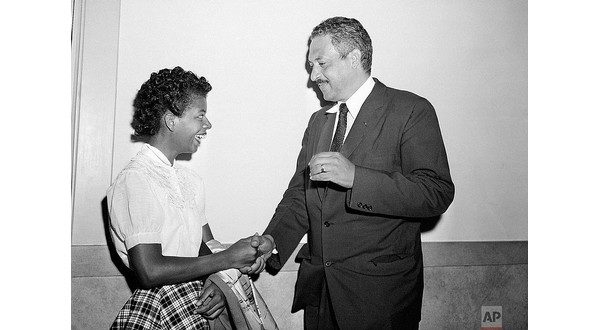
Thurgood Marshall talks with Elizabeth Eckford, 15, in the corridor of the federal courthouse at Little Rock Sept. 7, 1957, on the day of a hearing on the desegregation of Central High School. On Sept. 2, Elizabeth was the first Black student to attempt to enter the school, only to be turned back by armed National Guard troops. (Photo courtesy of Associated Press via Arkansas Democrat-Gazette)
A piece of history that sat for decades in a small federal courtroom in Little Rock is being restored with plans for it to become a living history exhibit for its role in the desegregation of Little Rock schools.
The judge’s bench that graced an auxiliary courtroom in Room 436 of the federal courthouse in Little Rock is first headed to Washington, D.C., for restoration, then for display at the U.S. Supreme Court. After that, it will be sent back to the capital city to take its place in what is planned to be a near-exact replica of the courtroom in which it sat and before which Thurgood Marshall and Wiley Branton argued the cause of desegregation of the Little Rock School District. The project is a joint effort between the U.S. General Services Administration — which acts as the federal government’s property manager — and the U.S. District Court of the Eastern District of Arkansas.
THE COOPER BENCH
Dubbed the “Cooper Bench,” for the civil-rights case argued by Marshall and Branton that ultimately led to the U.S. Supreme Court’s first significant enforcement of its Brown v. Board of Education decision in 1954, the bench sat for years in a small fourth-floor auxiliary courtroom. It was in that courtroom in 1956 and 1957 that the future Supreme Court justice teamed up with the legendary Pine Bluff attorney to argue in favor of desegregation of the Little Rock School District.
The landmark Brown v. Board of Education ruling swept away the “separate but equal” doctrine enshrined in the Plessy v. Ferguson ruling of 1896 but did nothing to address the mechanics of bringing about desegregation of the nation’s schools. A second ruling in 1955 ordering that desegregation be achieved “with all deliberate speed” also failed to break the logjam, as many Southern states worked to delay implementation for as long as possible.
Thus change, despite the support of the Supreme Court, came slowly and with great difficulty. In September of 1957, Arkansas lay squarely in the crosshairs of history as Gov. Orval Faubus defied President Dwight Eisenhower and refused entry to the students who became known collectively as “the Little Rock Nine.”
In the wake of Brown, the Little Rock School Board devised a desegregation plan intended to phase in integration districtwide over a six-year period beginning with the district’s four high schools, a plan that immediately ran into trouble.
THE “OTHER SHOE DROPPING”
In January 1956, an attempt by the parents of 33 Black students — ranging in age from 6 to 18 — to register at white schools was turned aside, paving the way for the Arkansas chapter of the NAACP to file suit in an attempt to expedite the process. Beginning as Aaron et al. v. Cooper et al., the lawsuit was argued by Marshall and Branton in August 1956 before U.S. District Judge John E. Miller, who ruled the School Board plan to be “prompt and reasonable.” In April 1957 the 8th Circuit Court of Appeals affirmed Miller’s ruling.
In August 1957, Pulaski County Chancery Court Judge Murray Reed issued a temporary restraining order blocking the district from moving forward with integration. That ruling was overturned days later in federal court by U.S. District Judge Ronald Davies, a visiting judge from Minnesota, utilizing the Auxiliary Courtroom in Little Rock’s federal courthouse. Davies’ ruling blocked the state from further proceedings in the matter.
On Sept. 2, 1957, the day before the fall semester was to begin, Faubus announced he was ordering the National Guard to prevent integration of Central High School. On Sept. 4, the nine students were turned away by National Guard troops. One of the students, Elizabeth Eckford, arrived alone to the school and was threatened and spat upon by a white mob that had surrounded the school.
On Sept. 20, 1957, Davies granted an injunction against Faubus, ruling the governor had exceeded his authority in obstructing the School Board’s plan and ordered the integration of Central High School to proceed. On Sept. 25, 1957, Minnijean Brown, Eckford, Ernest Green, Thelma Mothershed, Melba Pattillo, Gloria Ray, Terrence Roberts, Jefferson Thomas and Carlotta Walls stepped through the doorway of Central High School and, guarded by federal troops from the 101st Army Airborne Division, attended their first full day of classes at Central High School.
On April 28, 1958, the 8th Circuit upheld Davies’ injunction against Faubus and his ruling blocking the state from further legal action.
On June, 23, 1958, U.S. District Judge Harry J. Lemley granted a Little Rock School District request to delay desegregation until 1961. Lemley’s ruling was overturned the following August by the 8th Circuit.
On Sept. 12, 1958, the U.S. Supreme Court affirmed the 8th Circuit’s April and August decisions in a unanimous ruling signaling to the states that desegregation of the nation’s public schools was a constitutional imperative backed by the federal government. Described by Encyclopedia of Arkansas as “the other shoe dropping” in the Brown v. Board of Education decision, Aaron v. Cooper provided the mechanism for the federal government to enforce the foundation that was laid in Brown.
‘WHAT ARE WE GOING TO DO NOW?’
In 1996, as plans began for the construction of the Richard Sheppard Arnold U.S. Courthouse Annex — a 250,000-square-foot structure equipped with 12 courtrooms and 21st century audiovisual and computer technology — the question first arose as to what would become of the auxiliary courtroom. Former Federal Clerk Jim McCormack, who retired in mid-2021, said several ideas were kicked around over several years but said preservation of the historically significant courtroom as a teaching tool and a link to a critical juncture in the civil-rights movement was a paramount consideration. Progress was slow for several years, McCormack said, with no real sense of urgency until the U.S. Department of Housing and Urban Development expressed interest in the space sometime in late 2019 or early 2020.
“We went, ‘oh, crap, what are we going to do now?'” McCormack recalled.
The plan that emerged was to clear the auxiliary courtroom of its furnishing and fixtures and to recreate an “era-faithful” courtroom inside the 1st floor courtroom in the old courthouse. That courtroom, previously used by Chief U.S. District Judge D. Price Marshall Jr., sits next to his chambers.
U.S. Supreme Court Chief Justice John Roberts highlighted the courtroom’s role in desegregation and the plan to preserve it in his 2022 year-end report on the federal judiciary. Roberts applauded the project, saying that, “these important artifacts will be used to hold court once again,” and will do double duty as a teaching tool for programs about the events of 1957.
To get to the courtroom, Marshall said, visitors will pass through a set of double doors that originally formed the entrance to the auxiliary courtroom into a short hallway entrance that will be lined with photos and exhibits explaining the timeline of events. Furnishings and artifacts, he said, are planned to be authentic right down to the water fountain that sat in the hallway outside the courtroom.
To get there required close coordination between Marshall and GSA Regional Commissioner Giancarlo Brizzi, who said he was excited to partner with Marshall and the district court personnel in the creation of the era-faithful courtroom. The project aligns, Brizzi said, “with GSA’s commitment to preserving America’s historic building legacy while also allowing us the opportunity to capture the essence of the historic Cooper v. Aaron case.”
REMINDER OF HISTORY
“We need reminding of our history,” said Marshall, “the good and the bad. As bad as some of the events were, there was good in the use of the federal court to bring justice.”
According to GSA, the Cooper Bench project is intended to be completed in two phases. Phase 1, which began last October with demolition of the auxiliary courtroom began with the removal of the furnishings — gallery pews, jurors’ box, flooring, etc. — and asbestos abatement in the 1st floor courtroom space where the replication will be placed. Phase 1 is scheduled for completion by the end of March with the installation of new flooring, a bench platform, painting, and the re-installation of most of the furnishings.
Phase 2, which GSA said will take about six months to complete, is scheduled to begin this fall and will complete the final project details involving the historical artifacts needed to produce a faithful recreation of the courtroom as it existed in September 1957.
The judge’s bench, from which Davies issued his ruling, was sent to Washington, D.C., in October where it will be restored and placed in a Supreme Court exhibit until 2026, at which time the plan is to return the bench to Arkansas for permanent placement in the era-faithful courtroom.
In his year-end report, Roberts said the Cooper Bench project will provide important information in how the system of federal courts works and, “will give visitors an opportunity to transport themselves in place and time to the events in Little Rock of 65 years ago.”
“It’s important for people to not only hear about our history,” Marshall concurred, “but to be able to see where it happened and place themselves inside of that moment.”
WebReadyTM Powered by WireReady® NSI










